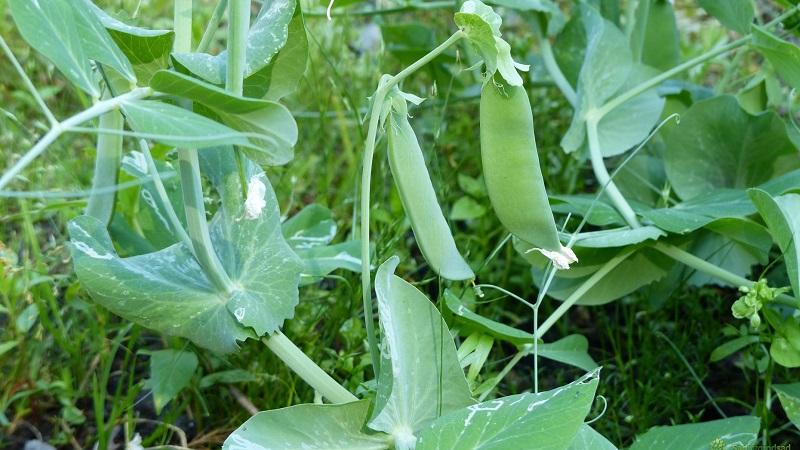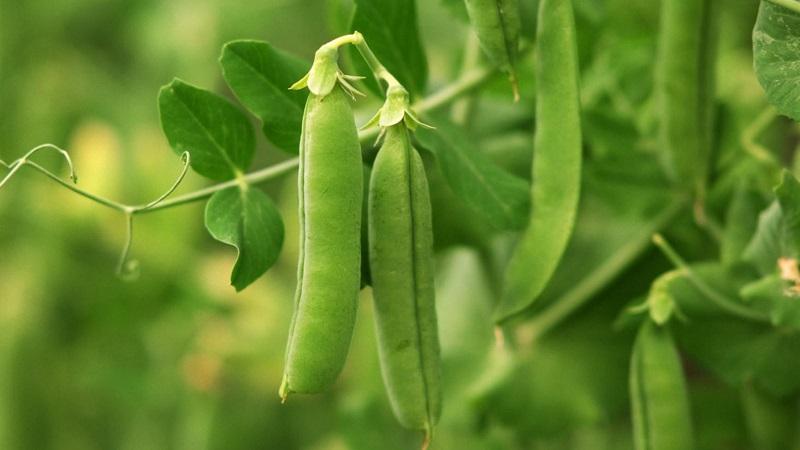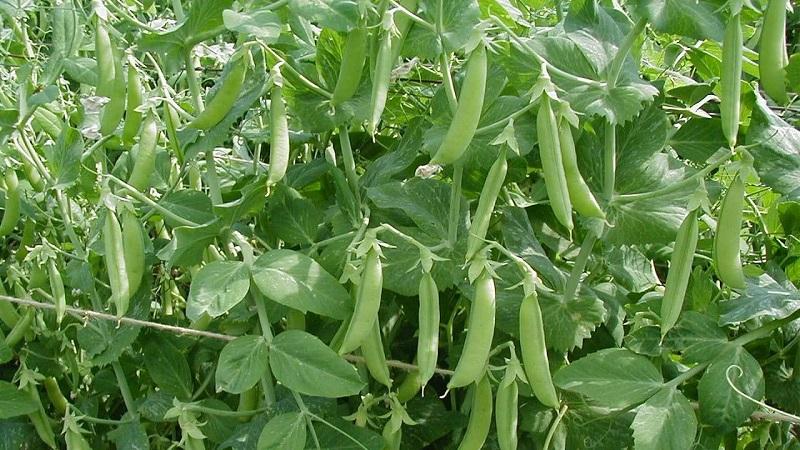What are the varieties of peas - an overview of varieties with photos and detailed descriptions
Peas are an annual crop known for their taste and nutritional value. All over the world, plants are grown with different colors and shades of seeds: yellow peas, white, green, and even black and red peas.
The plant is popular with both farms and private owners. Almost all summer residents plant its seeds on their site. Caring for plants is not difficult, the main thing is to choose the right place for planting and the variety that will meet your expectations.
The content of the article
Pea species
By maturity
The growing season for peas lasts 45 to 125 days..
Depending on the ripening period, the following varieties of peas are distinguished:
- early maturing, the period from germination to fruits of technical maturity is from 46 to 55 days, depending on the specific variety;
- mid-season, here from germination to technical ripeness 54-80 days;
- late, is characterized by the period of fruit ripening to technical ripeness from 80 to 90 days.
Technical ripeness is the state of vegetableswhen they are suitable for eating and harvesting for storage, but their seeds are not ready for future reproduction ("not ripe").

If a pick up different varieties, then you can feast on your harvest throughout the summer season.
Low-growing varieties
A clear sign of the classification of this plant is its height. Low-growing varieties include plants with a stem height of 40-70 cm.
Consider the bright representatives of the undersized group - pea varieties with photos and descriptions (click on the name of the variety to see the photo):
- Calvedonian miracle - early ripe, fruitful variety. It takes 50 days from germination to harvest. The length of the plant reaches 70 cm. When growing, it is better to tie the stem to a support. The pods are oblong, about 8 cm long, inside 6-8 peas of dark green color. It can be consumed both fresh and used for preservation.
- Vera - early ripening variety, characterized by amicable ripening of beans. The growing season is 48 to 63 days. The plant reaches a height of 65 cm. The pod is straight or slightly curved, inside 6-8 seeds of yellow-green color. Recommended for fresh consumption, canning and processing.
- Alpha (sugar) - early maturing, with a stable yield, frost resistant. From germination to technical ripeness, it takes 46 - 53 days. The pod has a shape from slightly curved to saber-shaped, 7-9 cm long, inside it has 5 to 9 seeds of dark green color. Alfa peas can be eaten fresh, can be preserved and frozen.
Tall varieties
The group includes varieties with a height of 100 to 220 cm.
Let's talk about the main varieties of this group:
- Pharaoh - mid-season, characterized by high productivity, good immunity. Drought tolerant. Stem length is about one meter. Resistant to lodging. The ripening period of peas is 68-85 days from the moment of germination. The pods are straight or slightly curved with a blunt apex, with 3-6 fruits inside. The peas are light yellow in color.
- Prelado (shelling) - early ripening peas, characterized by simultaneous ripening of fruits and a stable yield. Resistant to lodging and heat. It tolerates frost well. From the emergence of shoots to the beginning of harvest, 45 - 55 days pass. The pods are short, straight, of medium width, 8 cm long. The peas are dark green. There are 8 peas in one pod.Peas have good fresh taste and are excellent for freezing and preservation.
- Oscar (sugar) - early maturing, high-yielding, disease resistant. The pod is slightly curved with a sharp end, 9 cm long. There are 9-12 dark green seeds in a pod. 69 days pass from germination to harvest. The variety is used fresh, for freezing and conservation.
- Belmondo - a high-yielding medium-early variety of French selection. The plant is resistant to lodging, tolerates frost well. The pods will not crack when picked. It is characterized by high taste.

Suitable varieties for Siberia
Due to the climatic conditions of Siberia, not all pea varieties are suitable for growing in this region.
Consider varieties recommended for the Siberian climate:
- Ambrosia (sugar) Are one of the most popular sugar varieties in Russia. Pea sugar Ragweed is early ripening, 45- 56 days pass from emergence to the beginning of harvest. In order for the plant to bear fruit for a long time and abundantly, it is necessary to water it in a timely manner, weed it from weeds, loosen the soil and feed it with mineral fertilizers. These peas are grown on trellises or tied up. Pod length 8-10 cm, inside 8-10 seeds with a diameter of 8-9 mm. Peas at the stage of technical maturity are green, when fully ripe they are wrinkled, light yellow. Reviews about Ambrosia peas the most flattering. Gardeners note its high taste, write that children love it very much, that the variety always gives a stable harvest and is good in any form (fresh, canned or frozen). Many European restaurants include Ambrosia peas in their seasonal menus.
- Altai emerald - a mid-season compact variety that gives excellent yields. The plant reaches 45 cm in height. The pods are slightly curved, wide. The peas are dark green, large, and have a sweetish taste. The fruits of this variety are used for fresh food, added to salads, frozen, canned.
- Premium grade - early ripe, high-yielding peas, characterized by the simultaneous ripening of fruits. The growing season is 57 days. Peas Premium are disease resistant. The pod is medium-curved, with a blunt apex, 8 cm long. Peas in the stage of technical maturity are green, 8-9 per pod. The variety has excellent taste, is suitable for fresh consumption, as well as for conservation and freezing.
Suitable varieties for the Moscow region and central Russia
Most popular varieties can be grown in the middle lane and the Moscow region., getting a full harvest. Consider the most popular variety suitable for this climate - Moscow delicacy.
Peas Moscow Delicacy Is a mid-season pea variety that is valued for the sweetness of its fruits. In reviews of this variety, you can often find the phrase “the taste of childhood”. These peas do not require a lot of space on your site, and caring for them is simple. Peas grow well on any land, only if the soil has an acidic composition, it is recommended to pre-lime it.
For a high yield, this variety does not care about the fertility of the land.... For best results, choose a shaded landing site. If the plant is located in the shade, it will greatly reduce its taste. The variety is versatile in use, but is especially appreciated fresh.

The best shelling pea varieties
The main difference between shelling pea varieties is coarse, tough pods... The seeds of such peas are starchy and high in calories. These peas are suitable for making cereals and soups. For this use, fully ripe pods are harvested. At the stage of technical maturity, such varieties can also be used in different versions, including fresh.
So what varieties are better to plant on your site?
Consider a few:
- Avola - these peas are recommended for fresh use, as well as for freezing and preserving.Early maturing (56-57 days). The amicable ripening of fruits is characteristic. The stem is simple. Common type leaf is green. Pods of medium length, 6-9 peas inside. Peas in technical ripeness are small, green, 6-9 pieces per pod.
- Alpha - early ripe peas. The growing season from the emergence of shoots to the beginning of harvest is 45-55 days. Plants grow up to 50 cm in length. Peeling pods, with a coarse parchment layer inside, saber-shaped. Medium peas, 5-9 per pod. The seeds are valued for their high content of protein, vitamin C and other vitamins, carbohydrates, and mineral salts.
- Telephone - late-ripening high-yielding variety of shell peas. The type Phone can withstand low temperatures for a long time. It is recommended to grow these peas on prepared, cultivated soil. If peas are grown for the first time in the allotted area, humus must be added. The taste of these peas directly depends on the level of soil fertility.
- Adagumsky - mid-ripening variety characterized by amicable fruiting. 68-73 days pass from germination to technical ripeness. Bred back in 1980 by the Crimean experimental selection station of the All-Russian Research Institute of Plant Production. It is grown throughout the territory of Russia, with the exception of the Northern, Lower Volga, West Siberian and Far Eastern regions. Peeling pods, straight shape with a pointed apex, up to 7 cm long, dark green. Seeds are yellow-green in color, cerebral, wrinkled, medium-sized. In the phase of technical maturity, the peas are dark green and have good taste.
- Dinga - mid-season peas of German selection. The stem length is up to 95 cm. The period from germination to technical ripeness is 53-70 days. The pod is slightly curved, with a pointed apex, 11 cm long, inside 9-10 peas. Seeds are light green, in technical ripeness they are dark green. Dinga peas are distinguished by good taste both fresh and canned. The plant is susceptible to powdery mildew and bean yellow mosaic virus.
- Karina F1 - peas are early ripe, with a consistently high yield. The pods are short, of medium width, with 6 peas inside. Peas in technical maturity are green, of the same size. Peas are resistant to low temperatures, highly resistant to fusarium wilt. In the southern regions, winter sowing can be practiced. Peas are suitable both for fresh consumption and for processing (freezing and preservation).
- Voronezh green - early maturing variety, characterized by amicable ripening of the crop. Bred in 1990 at the Voronezh Vegetable Experimental Station. It is grown in the North-West, Central Black Earth, North Caucasus, Middle Volga and Lower Volga regions. Peeling pod, pointed, slightly curved, inside 8-10 peas. Seeds are cerebral, yellow, emerald green in the phase of technical maturity. The variety is characterized by excellent taste both fresh and canned.

Unusual types of peas
Among the huge number of species, varieties of peas there are also originals:
- Vegetable miracle - high-yielding, early peas of German selection. The plants are vigorous, about 40-50 cm high. The variety is resistant to lodging and does not need support, forming an emerald hedge. The plant is resistant to most diseases of legumes, peas, and pests. Pods 10 cm long with large peas. This variety is also remarkable for its high taste.
- Viola - this mid-ripening pea was bred by the All-Russian Research Institute of Selection and Seed Production of Vegetable Crops. The variety is not picky about the soil and can grow on loamy, sandy loam soil. Peas are delicious both fresh and canned. The peculiarity is that pods can also be eaten.
- Chinese - mid-season, high-yielding peas. The length of the pods of this variety reaches 14 cm.
- Oregon - mid-early variety, 55 days pass from germination to technical harvest.The plant is tall, up to 1 m, so you need to install trellises. Oregon peas are characterized by the sweetness of the peas and the high flavor of the pods. Suitable for both fresh consumption and canning.
- Asparagus peas - they are also called "winged", because its pods are equipped with wavy projections extending from four sides, similar to wings. this plant has beautiful large flowers with petals of bright red or purple color.
- Pea variety Rocket - one of the brightest representatives of the leafless type of plants, when most of the leaves have transformed into additional antennae.
The best varieties of peas for open ground
Consider a few more varieties that will feel great outdoors:
- Troika - late variety of shelling peas. Ripening occurs 80-90 days after germination. The variety is considered universal.
- Salute - early ripe peas with high productivity. Plant height from 60 to 85 cm, no garter required. The pod grows 8-9 cm long with 7-8 peas inside. The variety is resistant to viral infections.

Dessert varieties
There are hardly any people who are indifferent to the sweet pods of young green peas. Consider the most dessert varieties that will be a wonderful delicacy in your garden:
- Zhegalova 112 - sugar, mid-season, high-yielding peas. It is characterized by high taste and decorative qualities.
- Sugar slider - early ripening (from germination to the stage of technical ripeness 53-55 days) variety of leafless peas. The plant has a long fruiting period among the early varieties. Stem 70-75 cm high, grown without support. Pods 10 cm long, slightly curved, narrow. Sweet peas, 8-9 pieces per pod. Great for fresh consumption, canning and freezing.
- Baby sugar - an early ripe high-yielding variety. The length of the plant is 75-80 cm, it does not need trellis and a garter. The pods are slightly curved, 10-12 cm long. The plant is characterized by excellent taste (soft, sweet), unpretentious care. The peculiarity of the variety is the absence of a parchment shell in the pods, which allows you to eat peas together with the pods. The fruits are suitable for fresh consumption and for processing.
How to choose peas: useful tips and tricks
Now there is a huge selection of excellent varieties... Choose the right option based on your taste preferences and growing characteristics in the region.
Grow this useful culture on its site is completely not difficult, you just need to follow the basic rules:
- To get an excellent harvest of peas, we recommend choosing an open, sunny place where water does not stagnate.
- It is better to fertilize the garden bed before sowing, using complex fertilizers or humus and ash.
- Remember that the plant does not like acidic soils. If this is your case, add lime to the mail before sowing.
- Planting seeds is usually done outdoors from March to June, as soon as the soil warms up to 10 ° C.
- Seeds require a lot of moisture to germinate.
- Peas do not tolerate heat well, so planting early is the best decision.
- During the germination phase, birds are especially dangerous for the seeds, so it is better to cover the seeds with non-woven material.
- During the growing season, peas will need top dressing, weed removal and watering.
- Peas are an excellent precursor for other vegetable crops, they have a beneficial effect on the soil.

Conclusion
In order for peas to please you with a high yield, choose a variety carefully, taking into account your needs and growing conditions. Whether you need an early harvest or want to enjoy peas at the end of summer and add them to your favorite harvests in the fall - look at the ripening period.
You can pick up varieties of different ripening periods and feast on the entire summer season. Pay attention to the exactingness of the variety to the soil, as well as the climatic conditions of growing.Also remember that peas come in shell and sugar varieties. Some plants need support - it all depends on your design decisions in the country.